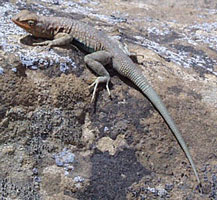|
Lizards
Many people think lizards only live in the desert. However, lizards are found almost everywhere around the world. There are almost 3,800 species worldwide. Over 110 kinds can be found in the United States. Lizards including iguanas, monitors, geckos, and horned lizards are the most common and fascinating reptile. In some areas of the US, people mistake lizards for salamanders. Salamanders and lizards are not related. Salamanders are amphibians like frogs. Lizards and snakes are closely related. |
|||||||||||||
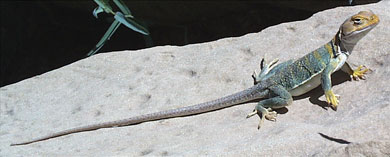 |
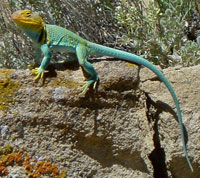 |
||||||||||||
|
Eastern
Collared Lizard
|
|||||||||||||
|
Size: The largest lizard is the Komodo monitor. It can grow to be over 10 feet long (3 meters). It can weigh nearly 300 pounds. The smallest lizard is a tiny gecko. Characteristics: Most lizards have dry, scaly skin, four legs, clawed feet, external ear openings, and a long tail. Lizards have a fragile, detachable tail. Many species have a weak point in their a tail. A slight tug or bump can be all that's needed to break it off. The thrashing tail distracts the predator. In some lizards, brightly colored tails increase the chance of losing a tail rather than losing a life. However, not all lizards lose their tails easily. For example, the collared lizard (above), has a sturdy tail that is rarely lost. Lizard tails help in balance and locomotion. Tails are also part of the social status and an area for fat storage. Losing the tail can be a serious problem for a lizard. If they live long enough, some lizards can grow back their tail. |
|||||||||||||
|
Food: Lizard diets vary. Most smaller types are insectivores. They eat insects and spiders. Other species are herbivores. Galapagos Island's marine iguanas feed on algae off the wet rocks. Spiny lizards are omnivores. They eat both plants and small animals. Some of the larger lizards like the Gila Monster are carnivores. They eat small animals including other lizards. Most lizards find their food visually through movement. Whiptails may use their sense of smell to find small animals under in the soil. Llizards have a small row of teeth on their upper and lower jaws. They also have teeth on the roof of their mouth. Food is crushed in their jaws, then swallowed with little chewing. |
|
||||||||||||
|
Side-blotched
Lizard
|
|||||||||||||
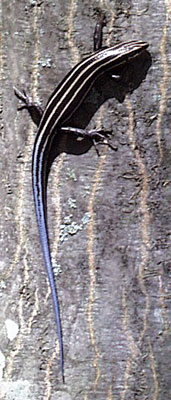 |
Habitat: Many lizards live in deserts, but others live in temperate forests, rainforests, prairies, marshes and streams, subterranean burrows, or rocky outcrops. However most lizards live on the ground or in trees. Lizards are the easiest reptile to watch because they are common. They are most active in the warm, daylight summer hours. They usually feed when temperatures raise above sixty-five degrees Fahrenheit. On very hot days, some lizards hide in burrows or underneath rocks. They may come back out in the cooler afternoon. Other species are more active during midday heat. Most lizards hibernate through the winter, but may come out on warm days to feed. Locomotion: Lizards move in interesting ways. Most lizards can run, climb, and cling. A few species can swim. A few can also glide through the air. More often, people see lizards quickly scamper over logs, rocks, tree trunks, and across the ground. Some lizards raise their bodies and run along on their hind legs. Several lizards that live on the ground get along with weak, nearly useless legs or do not have legs at all. |
||||||||||||
|
Southeastern Five-line Skink |
|||||||||||||
| Reproduction: Most lizards place their eggs in a nest. Other lizards do not lay their eggs, but give birth after hatching their eggs inside the body. Still other lizard species give birth to live young. The female lizards do not care for their babies. |
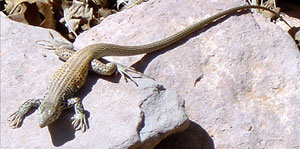 |
||||||||||||
|
Western
Whiptail
|
|||||||||||||
 |
Predators: The lizard has many enemies. Many lizards are eaten by raptors and other birds. They are also eaten by carnivorous mammals, snakes, and by other lizards. Defenses: Some lizards have the ability to easily detach their tails (below left), thereby giving them a chance to escape from the predator. When threatened, other lizards may bluff by swelling up, hissing, or lashing their tail. Collared lizards do a rapid series of pushups to scare their enemy. Some lizards are chameleons and can change colors. Some species change color for protection, while some become darker or lighter to change the amount of heat they absorb. The Gila monster and the beaded lizard are the only poisonous lizards. However, be careful when approaching any lizard. Not all lizards are harmless. Many lizards bite or have sharp spines. Some even squirts a thin stream of blood from their eyes. |
||||||||||||
|
Desert
Spiny Lizard
|
|||||||||||||
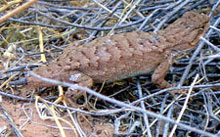 |
|||||||||||||
|
Lizard
missing its tail
|
|||||||||||||
|
Other Threats: Human activities sometimes threaten lizards. In some countries, people gather their eggs and hunt large lizards for food. Historically, lizards have been killed for their skins to make wallets, handbags, and other products. Today, many countries forbid killing lizards for their skins. Development and construction can destroy their habitats.
|
|||||||||||||
|
Plateau
Lizard, also known as Eastern Fence Lizard, Plateu Lizard, and Swift
Lizard
|
|||||||||||||
|
More Information | Main Page | Basics | More Detail | In Depth | WebQuest | | Living Things | NatureScapes | Note:
All photographs taken with a digital camera in Arizona, Colorado,
Nevada, North Carolina, and Utah.
Developed by Annette Lamb and Larry Johnson, 05/02. |
|||||||||||||
